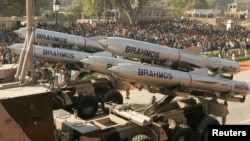India’s plans to sell advanced missile systems to countries like Vietnam got a boost this week after New Delhi joined an exclusive global club of countries controlling the export of missile technology.
Security analysts say membership in the Missile Technology Control Regime (MTCR) will also give India more leverage to overcome Chinese resistance in New Delhi's bid to join another another elite group controlling nuclear commerce; the Nuclear Suppliers Group.
One of the main weapons system India is set to export is the supersonic cruise BrahMos missile being produced by an Indo-Russian joint venture. The missile has a range of about 290 km and can be fired from land, sea and submarine.
Calling the BrahMos a formidable weapon, strategic affairs analyst Bharat Karnad at New Delhi’s Center for Policy Research says “those plans are going to be implemented soon. That is the first order of business.”
Besides Vietnam, other Southeast Asian countries such as Indonesia and Malaysia have also expressed interest in the BrahMos missile as they seek to improve their defense preparedness amid growing disputes with Beijing in the South China Sea.
Long reluctant to advance military cooperation with Southeast Asian countries for fear of angering China, New Delhi has shed those hesitations as Indian Prime Minister Narendra Modi embraces a closer strategic partnership with the United States.
Defense Minister Manohar Parrikar discussed the BrahMos missile exports on a visit to Hanoi last month.
Karnad says “this is an anti-shipping missile that any navy, including the Chinese navy would have to be very wary about.”
Other markets
Besides Southeast Asian countries, New Delhi is also eyeing selling the BrahMos missile to countries like South Africa, Brazil and Chile.
A huge arms importer, New Delhi hopes missile exports will add to its tiny basket of defense exports.
The BrahMos is one of the few success stories in India’s defense production. The country’s first locally built combat aircraft, the Tejas, was inducted Friday more than three decades after it was cleared for production. It is being described as the smallest lightweight, single-engine, tactical fighter aircraft in the world.
New Delhi, which has not signed the Nuclear Non-Proliferation Treaty (NPT) was excluded from nuclear commerce until it won a waiver under a 2008 deal with the United States.
Indian analysts say the MTCR membership has now put the stamp of legitimacy on New Delhi as a responsible nuclear power.
“You are mainstream. The ice is broken. Now you are sitting with important non-proliferation actors of the world,” says Rajiv Nayan at New Delhi’s Institute of Defense Analyses and Studies, pointing out that India is now part of a global rule-making body for missile technology.
Backed by the U.S., India has also set its sights becoming a member of the Nuclear Suppliers Group. But those hopes suffered a setback at a meeting in Seoul last month when Beijing raised strong objections to opening up the group to a country that has not signed the NPT.
Analysts say, however, New Delhi has gained significant leverage with China, which is not a member of the Missile Control Technology Regime, but wants to join it.
“At least India and China may talk. India may say I can support you for the MTCR provided you support me in the NSG,” says Rajiv Nayan.
“The tables have turned a bit,” feels Karnad. “We now have a counter leverage against China and it’s not a one-way street where they keep vetoing what India wants to do.”
China Sea Dispute Drives Interest in India's Anti-ship Missile

NEW DELHI —







